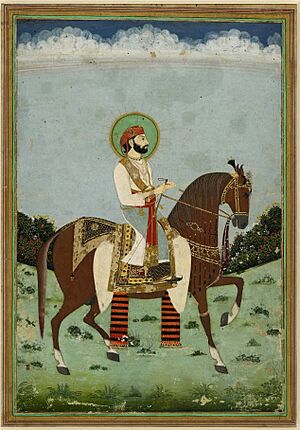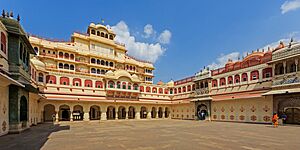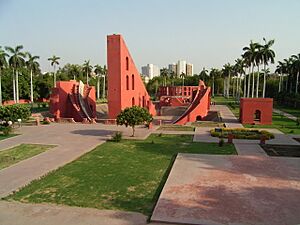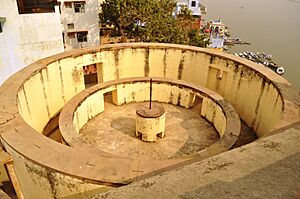Sawai Jai Singh facts for kids
Quick facts for kids Sawai Raja Jai Singh II |
|||||||||
|---|---|---|---|---|---|---|---|---|---|
| Saramad-e-Raja-e-Hindustan Raj-Rajeshwar Raj-Rajendra Shri Maharajadhiraj Maharaja Sawai Shri Jai Singh II Bahadur Shri |
|||||||||

Sawai Jai Singh's portrait (1725) from British Museum
|
|||||||||
| Raja of Amber | |||||||||
| Reign | 1699–1727 | ||||||||
| Coronation | 5 March 1699 (first) 25 January 1700 (second) |
||||||||
| Predecessor | Bishan Singh | ||||||||
| Raja of Jaipur | |||||||||
| Reign | 1727–1743 | ||||||||
| Successor | Ishwari Singh | ||||||||
| Subahdar of Malwa | |||||||||
| Emperor | Muhammad Shah | ||||||||
| Predecessor | Muhammad Khan Bangash | ||||||||
| Successor | Position abolished | ||||||||
| Born | Kunwar Vijay Singh 3 November 1688 Kharwa, Ajmer Subah, Mughal Empire (present day: Ajmer, Rajasthan, India) |
||||||||
| Died | 21 September 1743 (aged 54) Jaipur, Jaipur State, Rajputana (present day: Jaipur, Rajasthan, India) |
||||||||
| Spouse |
|
||||||||
| Issue | Sons
|
||||||||
|
|||||||||
| Dynasty | Kachwaha | ||||||||
| Father | Bishan Singh | ||||||||
| Mother | Rathorji Indra Kanwarji d. of Rao Kesari Singh of Kharwa in Ajmer | ||||||||
| Religion | Hinduism | ||||||||
Sawai Jai Singh II (born November 3, 1688 – died September 21, 1743) was an important Rajput ruler. He was the 29th king of the Kingdom of Amber. He later built the famous city of Jaipur and made it his new capital. Jai Singh became king of Amber when he was just 11 years old, after his father, Bishan Singh, passed away in 1699.
Jai Singh first served the powerful Mughal Empire. The Mughal Emperor Aurangzeb gave him the special title "Sawai." This title means "one and a quarter times superior," showing that Aurangzeb thought Jai Singh was very capable. He received even more titles later, like Maharaja Sawai, Raj Rajeshwar, and Shri Rajadhiraj.
Later in his life, Jai Singh became more independent from the Mughals. To show his power, he performed ancient ceremonies called Ashvamedha sacrifices. These had not been done for many centuries. He moved his capital from Amber to the new city of Jaipur in 1727. He performed two Ashwamedha sacrifices, one in 1734 and another in 1741.
Sawai Jai Singh II was very interested in math, building, and space. He built special observatories called Jantar Mantar in several places in India, including his capital, Jaipur. He even had a famous math book, Euclid's "Elements of Geometry," translated into Sanskrit.
Contents
Becoming King and Early Challenges
When Jai Singh became king of Amber, his kingdom was not very strong. He had very few resources, enough to support only about 1,000 cavalry soldiers. This was because of the long reign of the Mughal Emperor Aurangzeb. The kings of Jaipur usually tried to solve problems with the Mughals peacefully, as their kingdom was close to the Mughal cities of Delhi and Agra.
Six months after becoming king, Aurangzeb ordered Jai Singh to join the Deccan Wars. Jai Singh was a bit slow to respond. One reason was that he had to gather a very large army. He also had to get married in March 1701. When he finally reached Burhanpur in August 1701, heavy rains stopped him from going further. Because of this delay, his rank and pay were cut. However, he showed great bravery at the siege of Khelna in 1702. For his courage, his rank was restored, and he received the special title of Sawai.
Working with Later Mughal Rulers
The death of Emperor Aurangzeb in 1707 brought more challenges for Jai Singh. His friends in the Mughal court lost power in the fight for the throne. So, Sawai Jai Singh made an alliance with other Rajput states like Mewar and Marwar. They united against the new Mughal Emperor, Bahadur Shah I.
Jai Singh and the Marathas
Jai Singh was appointed to govern Malwa three times between 1714 and 1737. During his first time as governor (1714–1717), he successfully pushed back Maratha groups that tried to enter the province.
By 1728, the Marathas, led by Peshwa Baji Rao I, had become very powerful. They defeated the Nizam of Hyderabad. This allowed the Marathas to move freely through certain areas, reaching the borders of Malwa. When Jai Singh was appointed governor of Malwa again (1729–1730), he saw that the political situation had changed a lot. The Mughal Empire was weaker, and the Marathas were much stronger.
In 1732, Jai Singh was appointed governor of Malwa for the last time. He suggested to Emperor Muhammad Shah that they should make peace with the Marathas. However, other people at the Mughal court disagreed. Because of this, Jai Singh was removed from his position in 1737. He was practically the last governor of Malwa, as the region soon fell under Maratha control.
During this time, a Persian ruler named Nadir Shah attacked the Mughals. He defeated them at Karnal in 1739 and then looted Delhi. Jai Singh stayed in his own state during this chaos. He knew troubled times were ahead, so he started building many strong forts around his kingdom. Many of the forts you see today in the former Jaipur state were built during his reign.
Jai Singh's Military Power
Jai Singh made his kingdom bigger by taking land from the Mughals and rebel leaders. Sometimes he paid for the land, and sometimes he fought for it. He gained a lot of land in Shekhawati, which also gave him many strong soldiers for his growing army.
Jai Singh's regular army had about 40,000 men. He was very smart about warfare. He made sure his army had a lot of artillery (cannons) and plenty of supplies. He also made his foot soldiers use matchlocks (early guns) instead of the traditional Rajput sword and shield. He understood that firearms were changing how wars were fought. He prepared his army for this new way of fighting by giving them the best firepower.
Jai Singh even created an experimental weapon called the Jaivana. This huge cannon was built before he moved his capital to Jaipur. It is still the largest wheeled cannon in the world! In 1732, as governor of Malwa, Jai Singh had 30,000 soldiers, half horsemen and half foot-musketeers. This was in addition to his forces in other areas and in his forts.
Jai Singh's Goals in Rajputana
Jai Singh's strong army made him the most powerful ruler in Northern India. Other kings looked to him for help and protection. The Marathas were expanding their control and raiding northern areas, which worried the Rajput chiefs. Jai Singh called a meeting of Rajput rulers at Hurda in 1734 to discuss this danger, but they couldn't agree on a plan.
To stop the Marathas, Sawai Jai Singh wanted to create a strong alliance of Rajput states, led by Jaipur. He took over areas like Bundi and Rampura. He also made a marriage alliance with Mewar and got involved in the affairs of other Rajput clans. However, these efforts only made other Rajput clans turn to the Marathas for help, which actually sped up the Maratha control over Rajasthan. Jai Singh's plans in Rajputana failed after the Battle of Gangwana.
Death and Succession
The Battle of Gangwana was Jai Singh's last major battle. He never fully recovered from the shock of it and died two years later, in 1743. He was cremated at the Royal Crematorium at Gaitore, north of Jaipur. His son, Ishwari Singh, who was less capable, became the next ruler.
Contributions to Society, Culture, and Science
Jai Singh was the first Hindu ruler in centuries to perform ancient Vedic ceremonies like the Ashwamedha sacrifices (in 1716) and the Vajapeya (in 1734). During these events, he gave away huge amounts of money to charity.
He was a follower of the Vaishnava sect and promoted Sanskrit learning. He also made important changes in Hindu society. He worked to stop the practice of Sati (a widow sacrificing herself) and reduce the wasteful spending often seen in Rajput weddings. Because of Jai Singh's efforts, the hated jaziya tax, which Aurangzeb had placed on the Hindu population, was finally removed by Emperor Muhammad Shah in 1720. In 1728, Jai Singh also convinced the Emperor to remove the pilgrimage tax on Hindus visiting Gaya.
In 1719, Jai Singh saw a big argument in the Mughal court about how to calculate an auspicious date for the emperor's journey. This made Jai Singh realize that people needed to learn more about astronomy. Even with wars and invasions, Jai Singh found time and energy to build amazing astronomical observatories.
He ordered five such observatories to be built: in Delhi, Mathura, Benares, Ujjain, and his own capital of Jaipur. His observations of the stars and planets were very accurate. He created a set of tables called Zij-i-Muhammadshahi to help people make their own astronomical observations. He also had important math books translated into Sanskrit, including Euclid's Elements of Geometry and works on trigonometry and logarithms. His observatories were used to correctly predict eclipses and other events in space. The tools and methods he used were even better than those used by European astronomers he invited to his observatories.
These observatories are known as the Jantar Mantar. They include instruments like the Ram Yantra (a cylindrical building), the Jai Prakash (a curved hemisphere), the Samrat Yantra (a huge sundial), the Digamsha Yantra (a pillar with circular walls), and the Narivalaya Yantra (a cylindrical dial).
The Samrat Yantra is a giant sundial. It can tell the local time, help find the Pole Star, and measure the position of objects in the sky. The Rama Yantra measures how high and in what direction celestial objects are. The Shanku Yantra can measure the latitude of a place.
Jai Singh's greatest achievement was building the city of Jaipur. It was first called Jai Nagara, meaning 'city of victory'. Later, the British called it the 'pink city'. This planned city became the capital of the Indian state of Rajasthan. Building the new capital started in 1725, and the foundation stone was officially laid in 1727. By 1733, Jaipur became the official capital, replacing Amber. The city was designed by Vidyadhar Bhattacharya using an ancient Hindu grid pattern for city-planning. Merchants from all over India came to this safe and rich city, protected by thick walls and a large army. A Sanskrit epic called 'Ishvar Vilas Mahakavya' tells the story of Jaipur's construction in detail.
Jai Singh also translated works by thinkers like John Napier. Because of all his achievements, Jai Singh II is remembered as one of the most brilliant kings of 18th-century India. Today, his observatories in Jaipur, Varanasi, and Ujjain are still working. The one in Delhi is not functional, and the one in Mathura disappeared a long time ago.
See also
- House of Kachwaha
- List of Rajputs




